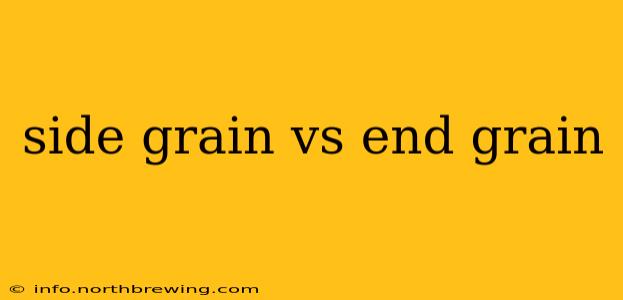Choosing the right type of wood for your project depends on several factors, and understanding the grain orientation is crucial. This article will explore the key differences between side grain (also known as flat grain or plain-sawn) and end grain, highlighting their properties, uses, and advantages. We'll also address some frequently asked questions to ensure you have a complete understanding.
What is Side Grain Wood?
Side grain wood refers to lumber cut parallel to the growth rings of the tree. Imagine slicing a log like a loaf of bread – each slice reveals the side grain. This method is the most common and cost-effective way to produce lumber, resulting in a wider range of board sizes and shapes.
Characteristics of Side Grain:
- Appearance: Shows prominent, linear grain patterns. The grain lines run generally parallel to the longest dimension of the board.
- Strength: Offers good strength and stability along the grain, making it suitable for many applications. However, it's less resistant to splitting than end grain.
- Workability: Relatively easy to work with using standard woodworking tools.
- Durability: Moderate durability; susceptible to warping and cupping over time, especially in fluctuating humidity conditions.
What is End Grain Wood?
End grain wood is created when the cut is perpendicular to the growth rings of the tree. Think of cutting a log across its diameter – the exposed surface reveals the end grain. This produces a unique and visually appealing surface.
Characteristics of End Grain:
- Appearance: Displays a distinctive pattern of concentric growth rings.
- Strength: Exceptionally strong and durable, especially in compression. Highly resistant to wear and tear.
- Workability: Can be more challenging to work with due to its density and the need for specialized tools.
- Durability: Highly durable and resistant to damage. This makes it ideal for high-traffic areas.
Side Grain vs. End Grain: A Comparison Table
| Feature | Side Grain | End Grain |
|---|---|---|
| Appearance | Linear grain pattern | Concentric growth ring pattern |
| Strength | Good along the grain | Exceptionally strong, especially in compression |
| Durability | Moderate, susceptible to warping | High, resistant to wear and tear |
| Workability | Easy | More challenging |
| Cost | Generally less expensive | Generally more expensive |
| Common Uses | Furniture, flooring, wall paneling | Cutting boards, butcher blocks, countertops |
What are the common uses of side grain wood?
Side grain wood's versatility makes it suitable for a wide range of applications. Common uses include furniture construction (tables, chairs, cabinets), flooring, wall paneling, and general carpentry projects. Its relatively easy workability and affordability contribute to its popularity.
What are the common uses of end grain wood?
The superior durability and resistance to wear make end grain wood ideal for applications requiring high resilience. Common uses include cutting boards, butcher blocks, countertops, and workbench tops. The dense structure effectively resists knife cuts and other forms of damage.
Which is better, side grain or end grain?
There's no single "better" choice; the optimal grain orientation depends entirely on the intended application. Side grain is better suited for projects where aesthetics and ease of working are prioritized. End grain excels in applications where exceptional durability and resistance to wear are paramount.
Is end grain more expensive than side grain?
Generally, yes. End grain lumber is often more expensive because of the higher yield loss during manufacturing and the specialized processing required. The superior durability and resistance to wear often justify the higher cost for specific applications.
How do I identify side grain and end grain?
Identifying side grain and end grain is relatively straightforward. Side grain shows parallel lines running along the length of the board, whereas end grain shows concentric circles representing the tree's growth rings. Observe the wood's surface closely to determine the grain orientation.
This comprehensive guide should equip you with the knowledge to confidently choose between side grain and end grain wood for your next project. Remember to consider the project's specific needs, desired aesthetic, and budget when making your decision.
